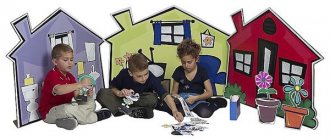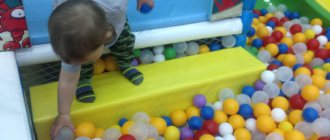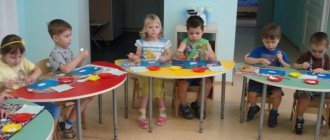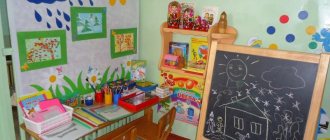Developing mathematical knowledge is not just learning to count
We live in an age of technology. Mathematical knowledge and much related to the exact sciences are needed for everyday life. It's not even a matter of:
- be able to count (minimum);
- know complex mathematical formulas by heart (maximum).
The general concept of the development of mathematical abilities in preschool children is presented in the works of researcher A.V. Beloshistaya. The author explains what we should mean in the words “development of mathematical abilities.” These are skills that will invariably come in handy to:
- be able to look for new solutions;
- deeply understand the essence of a phenomenon or fact;
- build logical connections;
- see the problem as a whole.
Agree, a lot! According to Beloshistaya, math classes in kindergarten should develop the child intellectually. And also prepare him to understand mathematical and logical information at school. Preparation – work with both motor skills and the development of logical structures.
Mathematics gives not just knowledge, but develops a special style of thinking. This science provides enormous potential for the formation of intelligence from kindergarten age. There is no time to waste; the most important mental logical structures are organized at the age of 5-11. This means that emphasis should be placed on mathematics from the senior group of kindergarten. But it is possible earlier.
There are games and activities that teach children to direct their thinking in a logical direction from the age of 2-3. A child may still speak poorly, but can already solve intellectual problems (for his age). The book “Formation of elementary mathematical concepts in kindergarten” suggests studying with children 2-7 years old. It offers methods and examples of classes. The book appears and disappears in the “Labyrinth” - you need to have patience to “catch it”.
For the middle group (4-5 years old) there is a publication entitled “Formation of elementary mathematical concepts” . It contains tasks and game exercises, you can directly take them and use them. The main part of the literature devoted to the development of mathematical thinking is designed for 5-6-7 years, we will return to it.
Kindergarten teachers are given an important task - to awaken interest in mathematics. This can be done through entertaining gaming activities. The process will not go far without self-education at home. There is an endless field of activity for parents here.
Diagnosis by FEMP in the older group
Carrying out diagnostics involves monitoring the quality of education of each student individually. The lesson is based on individual communication between the teacher and the child.
Coloring pages on traffic rules for a preschooler 3-4 years old
The teacher gives each student a task in turn and observes the process of thinking and the result obtained. In the process of such diagnostics, children perform tasks of the following nature:
- Name all the geometric shapes located on the desktop. If the child finds it difficult to name the figure, the teacher poses the question differently: asks to point to the figure he is naming.
Important! Children often forget the names of shapes due to excitement, but they know exactly what it looks like when they hear the name.
- Arrange identical objects in order of increasing or decreasing length. The teacher can suggest the student an algorithm of actions by asking leading questions: “Which subject is the longest of the remaining ones?” Answering this question, it will not be difficult for the child to put them in order.
- Be able to count the number of objects, one more or less than the teacher shows. For example, when a preschooler is shown a picture of six squirrels, he must count seven nuts.
- Build a regular pyramid of cubes or cylinders so that the base is the widest object and the top is the narrowest. The teacher is allowed to hold the pyramid and adjust the placed blocks so that they do not fall.
- Carry out entertaining gymnastics without hesitation: the preschooler, at the request of the teacher, shows with his left or right hand other paired organs and parts of the body - ears, cheeks, eyes, eyebrows, etc., from the side that the teacher names.
- After forming a column, the children must name the person in front and the one standing behind. Guys should not stand closer than a meter from each other.
Children lined up in a column
- List the names of the parts of the day; leading questions are allowed, for example: “When are you going to kindergarten, what time of day is it?”
- Name the days of the week in order. When a child finds it difficult to answer or makes a mistake, the teacher can ask: “if today is the fourth day of the week, what is it called?”
You don't have to understand how it works. The main thing is to do
The fact that mathematical and logical knowledge must be taught on time has become clear long ago. That is why preschool educational institutions spend so much time on mathematics. This discipline teaches you to think logically and not be afraid to use flexible thinking. The goal of a math program for preschool children is to teach them to grasp relationships and dependencies. And also create designs from objects, words and signs.
System is very important in learning. It is presented in this manual . If you don’t have time to systematize your knowledge, you can take ready-made workbooks for the appropriate age and start studying from them. You don’t even need to particularly understand the theory – you just have to do it. Parents and teachers will be helped by workbooks for 5-6 years old, compiled by Kondratyeva:
- "Math games in pictures for 5-6 years old" . General exercises are given, as well as tasks for the prevention of dyscalculia (impaired counting skills).
- "Counting and comparing numbers within ten" . The goal is the same, the tasks are different.
- . ” All three books are suitable for parents and educators who want to develop children.
Bortnikova produced a good notebook. The publication for 4-6 years old is called “Getting Ready for School. Development of mathematical abilities" . It introduces preparatory group students to geometric shapes, numbers, simple operations, and teaches comparison. The author has many other good books. For example, “Fun puzzles” for the little ones. She will interest younger children with bright pictures and rhymes.
Books by Yulia Glagoleva aimed at intellectual development are popular. The publications include quite complex tasks. From the book “Development of mathematical abilities. 1-2 grades. Federal State Educational Standard" parents sometimes try to give something to older preschoolers. But often it’s too early for them. And from a similar publication for grades 3-4 - even more so. But remember these manuals, they will be useful to schoolchildren.
FEMP in integration with other types of children's activities in accordance with the Federal State Educational Standard
Tatiana Svetenko
FEMP in integration with other types of children's activities in accordance with the Federal State Educational Standard
Brief summary of the sections of the program on FEMP in preschool educational institutions
• “Quantity and counting”: ideas about set, number counting, arithmetic operations, word problems.
• “Value”: ideas about various quantities, their comparisons and measurements (length, width, height, thickness, area, volume, mass, time)
• “Form”: ideas about the shape of objects, geometric figures (flat and three-dimensional, their properties and relationships.
• “Orientation in space”: orientation on your body, relative to yourself, relative to objects, relative to another person, orientation on a plane and in space, on a sheet of paper (blank and checkered, orientation in motion.
• “Time orientation”: understanding the parts of the day, days of the week, months and seasons, developing a sense of time.
Program problems in mathematics
educational - what we will teach the child (teach, reinforce, exercise, generalize, form, expand, introduce)
developing - what to develop, consolidate: - develop the ability to listen, analyze, the ability to see the most important, essential, development of awareness, - continue the formation of logical thinking techniques (comparison, analysis, synthesis)
educational - what to cultivate in children (mathematical ingenuity, intelligence, ability to listen to a friend, accuracy, independence, hard work, a sense of success, the need to achieve the best results)
speech - work on active and passive vocabulary specifically in mathematical terms
Teaching methods in mathematics classes:
Game-based - all classes are structured in a playful way, using various didactic games and exercises.
The verbal method in elementary mathematics does not occupy a very large place and mainly consists of asking questions to children. The nature of the question depends on the age and the content of the specific task. - at a younger age - direct, specific questions: How much? How? - in the older years - mainly search engines: How can this be done? Why do you think so? Why? For what? For what? The following are also used: - explanations (how to complete this task, - instructions from the teacher (mainly with children), - an action plan for senior preschool age.
Practical methods - exercises, game tasks, didactic games, didactic exercises - are given a large place. The child must not only listen and perceive, but must also participate in performing a particular task. And the more he plays educational games and completes assignments, the better he will learn the material on FEMP.
Visual methods: - demonstration material - it is large in size, bright, colorful, varied. - handout, small material that is distributed to each child.
Mathematical games are an effective means of developing preschoolers’ cognitive interest in mathematics
Integration of the development of mathematical concepts is carried out through the following educational areas:
Social and communicative development
Cognitive development
Speech development
Artistic and aesthetic development
Physical development
Integration of mental and physical activity can be carried out in the process of filling physical education activities with mathematical content:
• compare objects by size and shape;
• determine the left and right sides;
• we work on orientation in space relative to our body;
• we use flat and three-dimensional geometric shapes, numbers, number cards;
• we use cards depicting the seasons and parts of the day;
• we use counters (quantitative and ordinal counting);
• we pay in order (first, second, etc.);
• we count the number of caught players (in outdoor games, brought objects (in relay races);
• we play outdoor games with mathematical content “Get in the circle”, “Find yourself a partner”, “Classes”, “Make a figure”, “relay races in pairs”, “Whose team will throw more balls into the basket”;
• physical education and mathematics leisure;
Children, not realizing the load, count, reflect, think.
The assimilation of mathematical concepts is closely related to the mastery of speech and the development of thought processes. The child gradually learns to explain the progress of tasks.
• We widely use such small folklore forms as proverbs, sayings, nursery rhymes, jokes, counting rhymes, riddles;
• we use poetic forms of fiction;
• read fairy tales and stories that contribute to the formation of ideas about quantitative relationships between parts of the day, days of the week, seasons, size and orientation in space.
• In any of the fairy tales, be it folk or original, there are a number of mathematical concepts. “Kolobok” will introduce you to ordinal counting, “Teremok” and “Turnip” will help you remember quantitative and ordinal counting, and even the basics of arithmetic operations.
The lesson on artistic and aesthetic development is interconnected with mathematics.
Type of activity: “Fine”, “Construction from a variety of materials”, “Musical”.
• We select topics that help visually and tactually help the child remember and experience mathematical concepts in more detail. “Plasticine numbers”, “Multi-colored mosaic”, “Big and small houses on our street”, etc.
• In music classes we use musical and didactic games to develop a sense of rhythm, which contribute to the development and consolidation of some mathematical definitions.
In the cognitive research area, with the help of experiments, a child easily, with interest and without much difficulty acquires new mathematical knowledge.
• We form an active attitude towards our own mathematical and cognitive activities.
• We develop the ability to generalize, compare, identify and establish the simplest patterns, connections and relationships.
• We create conditions for the manifestation of children's activity in mathematical problem-search situations.
• We develop the need for intellectual communication.
• We create conditions for active and independent cognitive and research activities for children.
• We encourage children to engage in joint research activities and experimentation.
• We develop each child’s individuality, initiative, and desire to use existing knowledge and skills in new conditions.
The social and communicative development of preschool children occurs through play as a leading children's activity. Play gives children the opportunity to recreate the adult world and participate in an imaginary social life. All conditions have been created for this in the group.
Tasks:
• Assimilation of norms and values accepted in society.
• Development of communication and interaction of the child with adults and peers.
• Formation of independence, purposefulness and self-regulation of one’s own actions.
• Development of social and emotional intelligence, emotional responsiveness, empathy.
• Formation of readiness for joint activities.
• Formation of positive attitudes towards various types of work and creativity.
• Formation of the foundations of safety in everyday life, society, and nature.
Mastering the tasks of mathematical development of preschoolers is carried out both in activities organized by the teacher - developmental and educational situations, entertainment and leisure, in the process of carrying out children's projects, and in free independent activity in the conditions of a developing subject-spatial environment, in specially organized play libraries, game centers, experimentation centers .
Thus, an integrated approach implemented in the process of mathematical development of preschool children will ensure the achievement of readiness for school, namely the necessary and sufficient level of development of the child for his successful mastery of the basic general education program.
Introducing mathematics in a playful way
For a child, everything in the world is a game. And the game is both study and work, and a way of understanding reality. It needs to be included in the educational process. That is, to lead, direct, organize. Thus, it is possible to influence different aspects of the personality: in total, sensations, consciousness, will and behavior.
Children enjoy play activities as a process. Teachers and parents have a different goal. They need to develop a preschooler, put certain knowledge into his head, and develop personal qualities. Didactic games and exercises are especially useful. They provoke relaxed interaction between participants and teach them how to communicate.
Board games are very helpful in forming ideas about forms, sequences, contradictions and other things. They save you right away. You can make cards for such games yourself. But there are ready-made game sets, they are bright and cost a penny. This is for example:
- lotto “Logical tables” for 3-6 years;
- games like “What’s extra?” (there are many options, for example this one from 3 years old and this one for 4-7 years old );
- funny toy “Whose cat is bigger?” to compare numbers;
- "Find a similar figure";
- "Katamino" (mini road version) develops spatial thinking.
Types of classes in FEMP
Classes are held, according to the training manual by Pozina and Pomoraeva, once a week. In September, the first week is reserved for adaptation, so only three lessons are planned this month.
Exercises to develop logical thinking for preschoolers
Integrated classes
The integrated type of training is recognized as the most effective, since there is no direct teaching that can distract the child’s attention and deprive him of passion for the process. In such lessons, familiar cartoon characters are chosen as didactic material, for example, Masha and the Bear, who ask the children to help them make a difficult journey through the country of Mathematics.
The journey is accompanied by meeting new heroes who ask the guys for help in solving a task related to numbers or directions on a map.
Open classes
In open classes, embedded game technology is also used, but to a lesser extent. The lesson is more like a school one. It differs only in that it can be attended by teachers and parents of students. The purpose of the lesson is to demonstrate the skill of the teacher and the success of the children. Before the eyes of those present, a fairy tale is born, leading children through tasks and obstacles to the goal. Often in open lessons, teachers use presentations to illustrate the amount of material learned.
Open lesson on FEMP
Exercises with chopsticks
One of the most informative and accessible methods of teaching children to understand numbers is sticks. To understand the meaning of numbers, it is important not just to remember what it is called and looks like in writing. The whole point of learning to count is to understand how many units there are. Using sticks helps to understand the mathematical meaning of numbers. For comparing numbers with each other, Cuisenaire sticks are best suited, painted in different colors and having different lengths - in accordance with the numerical value of the stick.
Interesting! Each element of the set is visually attractive to the child, due to which acquaintance with numerical values is more effective.
Orientation on a piece of paper
Mandatory exercises on orientation skills on a sheet of paper contribute to all-round development. By the end of the year, children are able to name all the corners, specifying the location of each. Here such spatial concepts as “top”, “bottom”, “left”, “right”, “center” are combined.
Orientation practice sheet
Final lesson
The final lesson on FEPM in the senior group does not imply innovation. The lesson is conducted to consolidate the learned material. Most often, open lessons are held precisely at the final lessons, when the entire course has already been mastered by the children, and the teacher can demonstrate the fruits of his work there.
Didactic material necessarily includes elements of the game: familiar fairy-tale characters, balloons, colorful ribbons of different lengths. Summing up the training, the teacher prepares the lesson in such a way as to touch upon all previously studied topics and check each student how well he perceived the material throughout the year.
Examples of games for developing mathematical concepts
It is not necessary to buy game and educational sets to train structural thinking. You can use available tools: counting sticks, checkers, felt-tip pens and paper.
- Counting sticks will help preschoolers become familiar with the concept of shape. Simple and complex figures are built from the set, which are then easily transformed into each other. But to transform, you need to understand how. For example, from 5 sticks you can make two identical triangles. And from one on the table - one triangle (put it on the corner).
- What if you invite your child to draw a problem? He must come up with a plot, draw it and explain his problem. It just seems simple, but in reality it’s not very simple. This game develops creative thinking, imagination and invention. Kids learn to invent and express their thoughts.
- A simple and exciting game - checkers, preschoolers play with pleasure. Such activities teach you to plan moves, think abstractly, and develop ingenuity. Children who win at checkers often do better in school (our common humble observation). The game can be turned into a family hobby, and it will only bring benefits.
Mathematical riddles will help you master terminology
Another good thing is math-themed riddles. They teach kids independence and perseverance. After all, you often need to not just say the answer, but prove it. The beauty of riddles is that they teach you to use mental operations (synthesize, analyze, compare, generalize). Here are examples of riddles:
I am a dash in grammar, and who am I in mathematics? (Minus)
I have no corners, And I look like a dish, Like a plate and a lid, Like a ring and a wheel. (Circle)
The cunning brothers live in a difficult book. There are ten of them, but these brothers will count everything in the world. (Numbers)
There are also humorous puzzles that teach you to look for answers outside the box. For example: “You and I, and you and me, how many of us are there in total?” (2). “How many ends does the stick have, two, two and a half?” (in the latter case – 6).
Other games for logic and mathematics
Here are a couple of games that will allow preschool children 5-7 years old to get used to numbers. And also - they will consolidate quantitative ideas. You can make a set for classes yourself; these are cards with numbers and colored circles.
- What number escaped? We take several sets of cards with numbers from 0 to 10 and divide the guys into pairs. First, the couple puts the cards in order. Then one of the players closes his eyes, and the second rearranges several cards. When the first one opens his eyes, he should find changes. If found correctly, it starts leading. To make it more difficult, you can offer cards from 0 to 20 or from 10 to 20.
- Find a pair. The game is fun and noisy, so don’t disturb the kids from running around and having fun. We prepare cards with numbers and the corresponding number of circles. We divide the children into 2 teams. We lay out inverted number cards on one table, and with circles on the other. We invite the children to run around and then, at a signal, take cards from the tables. And after that, find a pair: if there is a number on the card, you need to find a child with a card with the same number of circles.
The first game was about seriation - building an ordered series. Rows can be organized according to different criteria: size, length, height, color. You can use pebbles, ribbons, dolls, sticks - literally anything that is at hand at a certain moment.
Synthesis games are very interesting - combining different objects according to a certain characteristic. For example, these are tasks where you need to choose:
- red balls;
- red, but not balls;
- round, but not balls;
- all the balls;
- the largest green ball (two characteristics are combined here - color and size, this is more complicated).
You can play with objects or cards. Another option is to offer to choose a different figure from a range. Or find three triangles in the picture. All these are also synthesis problems.
Another logical technique is comparison. To compare, you need to learn to concentrate on one feature and abstract from others. Let's say these are tasks like “choose the big yellow one”, “choose the big round one”, etc. Moreover, it is easier for kids to first learn the differences and then the similarities.
What material is given on FEMP in the senior group
FEMP in the senior group is focused on broadening one’s horizons, applying the acquired knowledge to everyday life, and having a correct understanding of the world.
Throughout the entire school year at preschool educational institutions, children learn new geometric shapes. By the end of the third quarter, children should distinguish the following shapes: circle, triangle, square, rectangle, oval. Also, ideas about a ball, cube and cylinder are introduced and reinforced. Classes are conducted aimed at training in dividing a circle and square into two and four parts.
Children in the senior group of preschool educational institutions
After division, everyone should be able to name and describe the resulting figures. The children learn to apply the acquired knowledge in geometry in life: they visually select objects of familiar shapes, tell how they are used: for example, they analyze a sheet of paper, determining what shape it is, where its corners are, where its sides are, what shape will be obtained if you bend the sheet in half.
Additional Information! Children develop ideas about the sequence of parts of the day. They skillfully determine morning, afternoon, evening and night. When asked by the teacher at lunchtime about the part of the day, they unmistakably answer “day,” and when asked what will happen after, they answer “evening,” remembering that before that there was morning.
Closer to the beginning of summer, the knowledge of the days of the week is completed. The children reinforce the concept of working days and weekends. They can easily navigate the middle of the week: if today is Wednesday, it means yesterday was Tuesday, and tomorrow will be Thursday.
Counting up to 10 is analyzed. The composition of the number and its nearest neighbors are compared. They learn to collect numbers up to 5 in units. By touch and sound they determine the number of objects (sounds), but no more than seven.
Didactic buttons for counting by touch
The skills of comparing various objects in three dimensions are developed - length, width, height. The smallest of the presented items is chosen as the measuring unit.
They train the ability to use landmarks “in front”, “behind”, “right”, “left”. To do this, they practice changing the direction of movement at the command of the teacher.
Important! Children do not acquire all these skills in one year of classes. Starting from the younger group, they gradually learned the elementary fundamentals of mathematics and the world around them. Education for the senior group is mainly aimed at consolidating the acquired knowledge and applying it in everyday life.
Developing math skills for life
There are many games online and in various educational textbooks for children aged 5-7 years. Often they try to divide them by age - this is justified, but you need to look at the development of a particular child. I would like to recommend a couple more good publications with exciting puzzles:
- A book for gifted children “Developing mathematical abilities” (for 6-7 years). Many interesting tasks from the easiest to the most difficult. Bright pictures and design will interest the child.
- “A complete course of preparation for school. For those who are going to 1st grade . The authors did their best and collected about 600 exercises - on mastering counting, preparing the hand for writing, etc.
For classes to be meaningful, they must be done systematically. Experts advise giving children logic exercises every day, little by little. This will teach the child to reason and draw conclusions, develop quick wits and intelligence. It will also increase self-esteem and arouse interest in studying at school. Basic skills in logic and mathematics will be useful not only in school, but throughout your future life.
It is much easier to interest preschoolers than older children. But by the 3rd-4th grade of school, motivation usually drops. So this favorable time should not be missed!
Developmental environment
The developmental environment is a system of material objects of a child’s activity that functionally model the content of his mental and physical development.
The physical and developmental environment is organized in such a way that every child has the opportunity to freely do what they love. The arrangement of equipment by sectors (development centers) allows children to be grouped into subgroups in accordance with their common interests: design, drawing, handicrafts, theater and play activities, experimentation. Materials that activate cognitive activity are required in the equipment: educational games, toys.
The kindergarten environment should ensure the safety of children's lives, promote the health and strengthening of the body of each child.
When creating a subjective development environment, you need to remember this:
- The environment must perform educational, developmental, nurturing, stimulating, organizing and communicative functions. But most importantly, it should work to develop the child’s independence and amateurism.
- 2. flexible and variable use of space is necessary. The environment must meet the child's needs and interests.
- The shape and design of the items are based on the safety and age of children.
- decorative elements should be easily interchangeable.
Each group should have space for conducting experimental activities with the participation of children.
- When organizing the subject environment in a group room, it is necessary to take into account the patterns of mental development, indicators of their health, psychophysiological and communicative characteristics, the level of general and linguistic development, as well as indicators of the emotional sphere and the sphere of needs.
- the color palette should be represented by warm pastel colors.
- When creating a developmental space in a group room, the leading role of play activities should be taken into account.
- Depending on the age characteristics of the children, the period of study and the educational program, the object environment for the development of the group should be changed.
It is important that the physical environment is an open system, not a closed system, that can adapt and evolve. In other words, the environment not only evolves, but also develops. Under any circumstances, the objective world that surrounds the child must be replenished and updated in order to adapt it to the new way of life of a given age.
Thus, when creating an object-developmental environment for any age group in a preschool institution, it is necessary to take into account the psychological foundations of constructive interaction between participants in the educational process, the design and ergonomics of the modern environment of a preschool institution, as well as the psychological characteristics of the age group for which the environment is intended.
We are talking about the age of the child, he has a need to play, and this must be satisfied, and not because business has its own time and need for entertainment, but because as the child plays, so he will work.”
These words belong to the wonderful teacher Alexander Makarenko, who in his teaching practice paid great attention to children's play.
Game is a type of activity of children, which consists in reproducing the actions of adults and the relationships between them and is aimed at orientation and knowledge of the subject and social reality.
A didactic game is a type of educational activity organized in the form of educational games that implement a set of principles of play and active learning, characterized by the presence of rules, a fixed structure of gaming activity and an assessment system.






